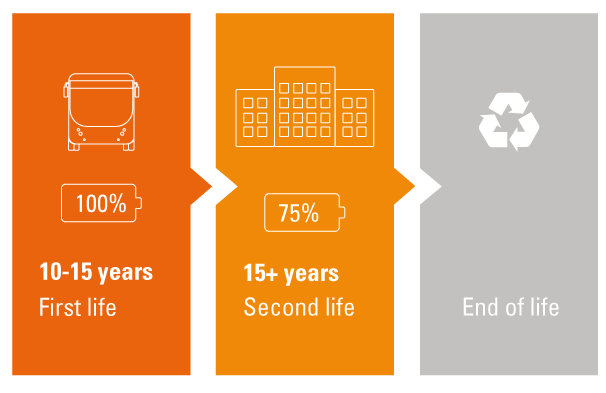The second life of batteries, an even more sustainable approach
The lithium-ion batteries used in light and heavy electric vehicles present challenges in terms of service life and recycling. An emerging solution is gaining in importance: the second life of lithium batteries. They have two lives before they can even be considered for recycling.
Their second life in stationary applications is envisaged as soon as their performance is no longer sufficient, i.e. at around 75% of their original state of health.
The second life of batteries makes it possible to reduce their carbon footprint by maximizing their useful life, paving the way for a more sustainable approach to electric mobility.
A second life based on the useful life of the battery
The lithium-ion batteries used in electric vehicles are subject to demanding in-vehicle use and natural progressive degradation over time (between 10 and 15 years): the chemistry used, the frequency of battery charging, the state of charge level during use and recharging, driving behavior or weather conditions all have an impact on this duration.
When they are no longer able to provide adequate range for electric vehicles – down to 75% useful capacity – they are generally replaced and then recycled. However, even after they have been retired, these batteries still have a lot to offer.
Once this threshold is reached, the battery’s storage performance is no longer sufficient to ensure a good range for the vehicle in which it is integrated.
Rather than being sent straight for recycling, used lithium-ion batteries can be reused in other applications once they have been removed from electric vehicles. These batteries can still store a significant amount of energy, although their capacity has diminished.
By using them in stationary applications that require less second life, immediate recycling is no longer the only option available, thereby extending their useful life.

Reusing batteries for stationary storage
Extending the life of batteries in stationary applications means delaying their recycling and therefore reducing their environmental impact. By analyzing the market and technical developments, these applications can be divided into three categories: stationary storage in front of the meter (FTM), stationary storage behind the meter (BTM) and mobile energy storage.
Stationary energy storage: second-life lithium-ion batteries can be used for stationary energy storage. For example, they can be integrated into solar or wind power installations to store excess energy and release it when demand is higher. This helps to better balance energy supply and demand, reducing the need to use peak fossil energy sources.
Emergency power solutions: used lithium-ion batteries can also be used as emergency power sources. They can be installed in commercial buildings, data centers or even critical infrastructures such as hospitals. These batteries can take over in the event of a power failure, ensuring a continuous supply of electricity and reducing dependence on diesel generators.
The battery’s initial and residual technical characteristics will help to guide its use in second-life energy storage.
After several years of operation in energy storage and a residual useful capacity of 50%, the batteries are no longer powerful enough to carry out the required activity. They are then recycled.
From first life to recycling: Forsee Power commits to transparency
1
LOGISTICS
Recovery of batteries from the electric vehicles of our electromobility customers and repatriation to our local industrial sites.
2
ANALYSIS
Analysis of the state of health of the batteries, with qualification of the technical characteristics by our teams of experts.
3
SORTING
Sorting of batteries according to analysis results for allocation to different stationary storage applications.
4
INTEGRATION
Integration of second-life batteries in containers according to the projet of our customers.
5
GO
After the first 4 phases, we give our agreement for the commissioning of the project integrating the second-life batteries.
6
RECYCLAGE
After several years of operation in energy storage, and with a residual useful capacity of 50%, the batteries are no longer powerful enough to ensure the required activity. They are then recycled.
